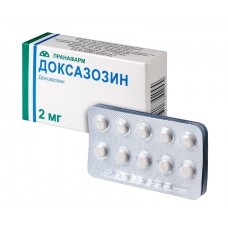Expiration date: 05/2028
Indications for use
Benign prostatic hyperplasia: both in the presence of arterial hypertension and with normal blood pressure. • Arterial hypertension: in combination with other antihypertensive agents (thiazide diuretics, beta-blockers, slow calcium channel blockers or angiotensin converting enzyme (ACE) inhibitors).
Contraindications
Hypersensitivity to doxazosin, other quinazoline derivatives (including prazosin, terazosin) or to any of the auxiliary components of the drug, other alpha-adreno blockers; orthostatic hypotension (including in the anamnesis), chronic infectious diseases of the urinary tract, urolithiasis, anuria, concomitant urinary tract obstruction, progressive renal insufficiency; severe hepatic insufficiency (insufficient experience of use); breastfeeding (in the treatment of hypertension), age up to 18 years (efficacy and safety have not been established); lactose intolerance, lactase deficiency and glucose-galactose malabsorption syndrome. Additionally, during treatment, symptomatic therapy of BPH is indicated: urinary incontinence due to overflow of the bladder, arterial hypotension.
Method of administration and dosage
The drug Doxazosin can be prescribed both in the morning and in the evening, and is intended for oral administration. It is taken once a day, regardless of food intake. The tablet must be swallowed without chewing, washed down with a sufficient amount of water. Benign prostatic hyperplasia The recommended starting dose of Doxazosin is 1 mg once daily in order to minimize the possibility of orthostatic hypotension and/or syncope. Depending on the individual characteristics of urodynamic parameters and the presence of BPH symptoms, the dose can be increased to 2 mg, and then to 4 mg and up to a maximum daily dose of 8 mg. The recommended interval for increasing the dose is 1-2 weeks. The recommended maintenance dose is usually 2-4 mg once a day. Arterial hypertension The dosage varies from 1 to 16 mg / day. It is recommended to start treatment with an initial dose of 1 mg once a day before bedtime. After taking the first dose, the patient should stay in bed for 6-8 hours. This is required due to the possibility of developing the phenomenon of the "first dose", especially pronounced against the background of previous diuretic use. If the therapeutic effect is insufficient, the daily dose can be increased to 2 mg after 1-2 weeks. Subsequently, the dose can be increased by 2 mg every 1-2 weeks. In the vast majority of patients, the optimal therapeutic effect is achieved at a dose of 8 mg per day. The maximum daily dose of the drug of 16 mg per day should not be exceeded. After achieving a sustained therapeutic effect, the dose is usually reduced (the average therapeutic dose for maintenance therapy is usually 2-4 mg per day). If a diuretic or other antihypertensive agent is added to therapy, it is necessary to adjust the dose of Doxazosin depending on the patient's condition, with further titration under the supervision of a doctor. In elderly patients and patients with impaired renal function, it is recommended to prescribe Doxazosin in normal doses. Patients with impaired liver function need careful dose selection. There is insufficient clinical data on the use of Doxazosin in patients with severe hepatic impairment.
Form of release
Tablets 1 mg, 2 mg, 4 mg. 5, 10, 15, 20 or 30 tablets in a contour cell package made of polyvinyl chloride film and aluminum foil printed varnished. By 10, 20, 30, 40, 50, 60, 70, 80, 90 or 100 tablets in cans of polyethylene terephthalate or polymer cans for medicines. One jar or 1, 2, 3, 4, 5, 6, 7, 8, 9 or 10 contour cell packages together with the instructions for use are placed in a cardboard package (pack).





